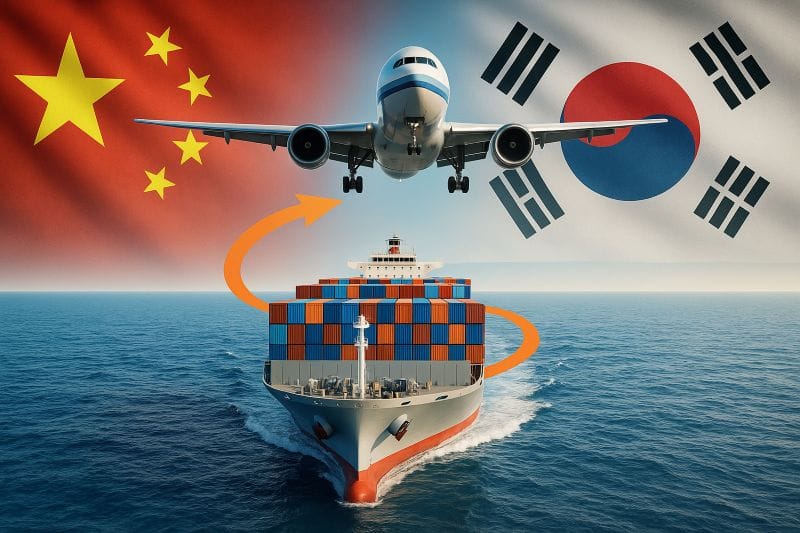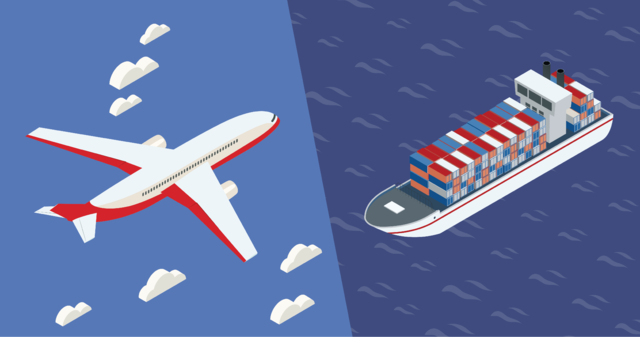- By TOP CHINA FREIGHT
- September 11, 2025
- Shipping
Table of Contents
Shipping from China to South Korea is a crucial trade route for businesses across Asia. Companies often face challenges such as high freight costs, customs complexity, and choosing between air and sea freight. However, a well-planned logistics strategy can minimize expenses, improve transit reliability, and streamline supply chains.

What are the main shipping options from China to South Korea?
Businesses typically choose from sea freight, air freight, or express courier services. The choice depends on cargo size, urgency, and budget.
| Shipping Mode | Average Cost | Transit Time | Best For |
|---|---|---|---|
| Sea Freight (FCL) | $800 – $1,200 per 20ft container | 3–5 days | Large shipments |
| Sea Freight (LCL) | $50 – $70 per CBM | 4–7 days | Small shipments |
| Air Freight | $4 – $8 per kg | 1–3 days | High-value/urgent cargo |
| Express Courier | $6 – $12 per kg | 1–2 days | E-commerce parcels |
Sea freight is most cost-effective for bulk cargo, while air freight and express services provide speed and reliability.
How long does shipping from China to South Korea take?
Proximity allows shorter transit times compared to other international routes.
| Route | Sea Freight Transit | Air Freight Transit |
|---|---|---|
| Shanghai → Busan | 3–4 days | 1 day |
| Shenzhen → Incheon | 4–5 days | 1–2 days |
| Qingdao → Busan | 3–4 days | 1 day |
| Ningbo → Incheon | 4–6 days | 1–2 days |
Transit times may vary due to weather, port congestion, and customs inspections.
What customs documents are required in South Korea?

| Document | Purpose | Issued By |
|---|---|---|
| Bill of Lading (B/L) | Proof of shipment | Carrier |
| Commercial Invoice | Declares goods’ value | Exporter |
| Packing List | Details cargo content | Exporter |
| Certificate of Origin | Verifies product origin | Chamber of Commerce |
| Import Declaration | Required for customs clearance | Korean Customs |
Freight forwarders often manage these documents to prevent delays and compliance issues.
What factors influence shipping costs?
Air freight is more expensive per kilogram than sea freight.
Heavier or oversized goods increase cost.
Peak periods raise freight rates.
Import duties, VAT, and product classification matter.
Oil price changes influence carrier pricing.
Air vs sea freight: Which is better for South Korea?

| Factor | Air Freight | Sea Freight |
|---|---|---|
| Speed | 1–3 days | 3–6 days |
| Cost | Higher | Lower |
| Cargo Size | Limited | Ideal for bulky goods |
| Reliability | Less affected by weather | Can face port delays |
Air freight suits urgent or high-value items, while sea freight is best for bulk, heavy cargo.
Port and airport options for shipping
China–South Korea shipments rely on major ports and airports.
| Chinese Port | Korean Port | Advantages |
|---|---|---|
| Shanghai | Busan | High frequency, well-connected |
| Shenzhen | Incheon | Efficient for electronics |
| Qingdao | Busan | Cost-effective for bulk |
| Ningbo | Incheon | Fast transit and handling |
Air shipments often use Shanghai Pudong, Shenzhen Bao’an, and Incheon International Airport for quick deliveries.
Understanding customs duties and taxes
South Korea applies import duties and VAT depending on product type.
| Product Category | Duty Rate | VAT |
|---|---|---|
| Electronics | 0–8% | 10% |
| Clothing | 8% | 10% |
| Furniture | 8–13% | 10% |
| Food & Beverages | 8–20% | 10% |
How supply chain and warehousing impact imports
Efficient storage and last-mile delivery improve logistics efficiency. Key practices:
- Using bonded warehouses in Korea for deferred duty payment
- Consolidating shipments to reduce handling costs
- Implementing inventory management software to track stock
- Coordinating trucking from ports to final destinations
Agencies offering warehousing support reduce operational complexity for importers.
Trends shaping China–South Korea shipping
Smaller parcels shipped more frequently
Faster, paperless processing
Eco-friendly shipping initiatives and low-emission vessels
Potential reduction in tariffs and fees
Case study: LCL consolidation reduces costs

How businesses can optimize shipping from China to South Korea
Consolidate shipments
Reduces per-unit cost
Book in advance
Avoid higher peak-season rates
Partner with experienced agents
Ensures compliance
Use tracking tools
Improve supply chain visibility
Plan for customs clearance
Reduce delays at ports
Conclusion
Efficient shipping from China to South Korea requires careful planning of transport mode, customs compliance, and cost management. Leveraging experienced freight agents and modern logistics tools can streamline deliveries, reduce risks, and improve supply chain efficiency. By consolidating cargo, tracking shipments, and understanding ports and taxes, businesses gain a competitive edge in the Korea–China trade corridor.
Need a Shipping Quote?
If you want expert guidance and peace of mind, our team is ready to assist.
TJ China Freight offers tailored solutions to help businesses of all sizes ship more reliably from China.

FAQ
Q1:What Incoterms are commonly used for China–Korea shipping?
FOB and CIF are most common. FOB transfers responsibility after loading, while CIF covers insurance and freight to the Korean port.
Q2:Are there restricted imports to South Korea?
Yes. Hazardous chemicals, certain foods, and medical devices require permits. Confirm restrictions before shipping to avoid fines or delays.
Q3:Is insurance necessary for shipments from China?
Yes. Insurance protects goods from damage, loss, or delays during sea or air transit. Agencies often offer coverage options.
Q4:Can small businesses use LCL shipments?
Absolutely. LCL allows sharing container space, reducing costs while ensuring reliable delivery for smaller orders.
Q5:How can customs delays be minimized?
Accurate documents, correct product classification, and experienced freight agents help expedite customs clearance.
